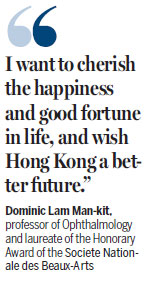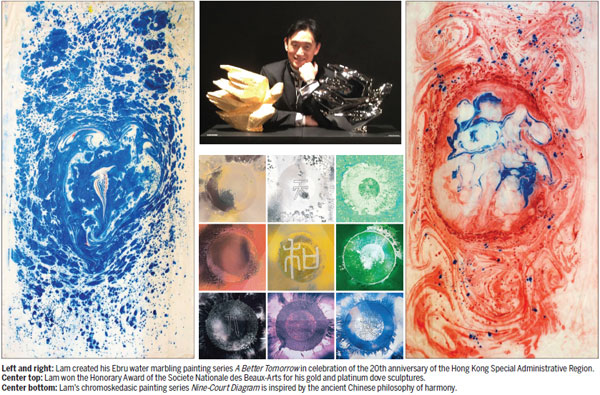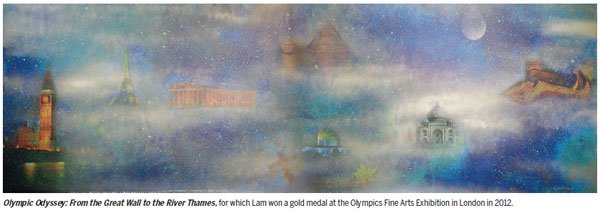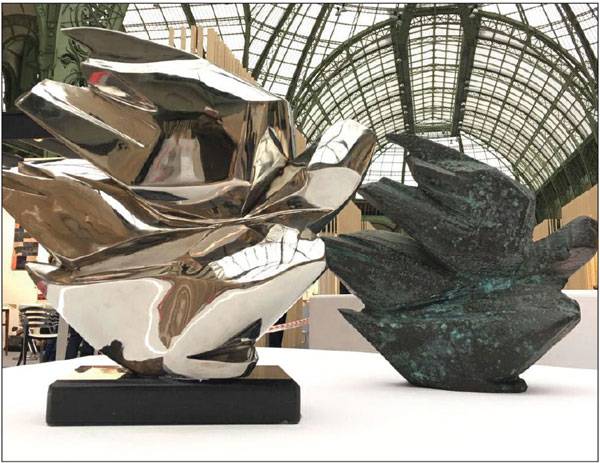A scientist's 'flight' to art for world peace
Updated: 2017-12-21 06:17
(HK Edition)
|
|||||||
Professor Dominic Lam Man-kit's passion for Chinese culture and paintings pays off with a prestigious French award, Carrie Qiu writes.
Professor of Ophthalmology Dominic Lam Man-kit had to celebrate his 70th birthday in Paris this year because a pair of doves he had sculpted 16 years ago was about to be exhibited in the Louvre Museum.
But, what he did not expect was that he was about to receive an award for the sculptures.
The gold and platinum sculptures, entitled The Doves of Peace, are an "appropriate and effective means to use art and Chinese culture to promote world peace and harmony", said Lam who was given the Honorary Award by the Societe Nationale des Beaux Arts, a French art association, on Dec 7 - a day after his birthday.
Although the doves were first crafted in 2001 along with a dozen of other animals, which make up his sculpture series Life, Lam's art journey began at the age of 4 when he learned traditional Chinese painting, fueling his desire to be a painter.
"I was born to a very poor family in Shantou and moved to Hong Kong when I was 4 months old. My parents didn't want me to be an artist," said Lam.

So, his life took a different path. Lam finished high school at 15, gained a scholarship to study mathematics in Canada at 16, earned a PhD in medical biophysics at 22, and started working at Harvard Medical School when he was 24.
By 40, he had invented a drug for secondary cataract - a complication of cataract surgery resulting in blurry vision - and set up the first biotechnology company in Texas. His early-1990s invention "edible vaccine" - a technique to transfer viral or bacterial antigens into vegetables and fruits - was named by Time magazine in 2001 as one of the 10 most important inventions of the 21st century.
Despite his scientific achievements, Lam's childhood dream has never been forgotten. He has continued to practice traditional Chinese ink wash and oil painting in his spare time. His favorite subjects are the universe and nature, sometimes combined - as in a surrealistic oil painting of yellow water lilies that he painted in 1997 in Houston and which now hangs in his office in Wan Chai. The colors of the water and the leaves floating on its surface are clouded like cosmic lights, while the yellow paint that's spattered all over the canvas mimics the stars and planets.
Lam said the universe and nature have always been his favorite subjects, since he studied theoretical physics at university.
But, his art journey has not been limited to the traditional forms. One day, in 1980, while developing photos of eyes in the darkroom, Lam realized that colors appeared in his black-and-white photos. He later found out it was because the chemical solution he used to make the photos was too thin.
His accidental discovery made him the inventor of chromoskedasic painting, or NanoArt. From then on, he couldn't stop using the solution to paint on black-and-white photographic paper. One of his representative works is Nine-Court Diagram, a series of nine paintings of human eyes in different vibrant colors. It is inspired by the ancient Chinese philosophy of harmony, Lam said.
In 2000, Lam met Taiwan sculptor Ju Ming, who is famous for his sculpture series Tai Chi, and became Ju's mentee. The following year in Ju's studio in Taiwan, Lam created his sculpture series Life - from which the pair of doves were showcased in the Louvre to win him the French award.
"I always try to celebrate the harmony of life and nature through my art," said Lam, adding that art is a universal language which needs no translation.
In recent years, the restless Lam has been devoted to another new art form - Ebru water marbling painting - a method of scattering oil paint onto the surface of water, then transferring it to an absorbent surface such as paper or fabric. The technique allows him to create patterns similar to smooth marble and, in his case, the results resemble cells and vessels.
Lam held an exhibition at the Hong Kong Convention and Exhibition Centre with a series of marbling paintings to celebrate the 20th anniversary of the Hong Kong Special Administrative Region. This time, he created a moon-shaped circle using the technique to represent the Chinese metaphor for "reunion".
"I want to cherish the happiness and good fortune in life, and wish Hong Kong a better future," Lam said.
Contact the writer at
carrieqiu@chinadailyhk.com
|
The Doves of Peace sculptures crafted by Dominic Lam Man-kit are an “appropriate and e ective means to use art and Chinese culture to promote world peace and harmony”.Photos Provided To China Daily |


(HK Edition 12/21/2017 page10)
